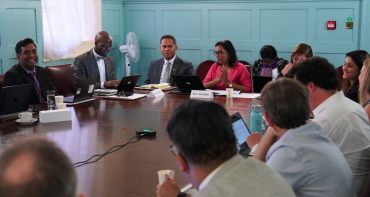By Marcel Le Roux, Strategic Engagement Manager, and Simon Butt-Bethlendy, Public Affairs Manager, Institution of Occupational Safety and Health (IOSH). IOSH is a Commonwealth-accredited organisation and founder member of the Commonwealth Communicators Group.

Living in and adapting to a rapidly heating world creates new hazards and challenges for workers everywhere. We know that across the Commonwealth, vulnerable workers are affected ever more seriously by changing environments. Principles of good safety and health can help make working lives better.
Humans everywhere should be able to work and earn their livelihoods in ways that do not harm them. Sadly, we know that this is truer for a few people than for most.
Vulnerable workers, extreme conditions
It’s estimated that around two-thirds of people working in the world today do so informally without protections provided by employers. Owing to climate change, many people work in places experiencing extreme weather, including excessive heat.
-
Up to 2.41 billion workers (71 per cent of the global working population) experience excessive heat every year.
-
This results in 18,970 work-related deaths annually and 2.09 million disability-adjusted life years (DALYs), which is a measure of overall disease burden.
-
9 out of 10 work-related exposures to heat happen outside exceptional heatwaves, and 8 out of 10 occupational injuries can be linked to these heat exposures.
-
Critically, according to the by 2030, 3.8 per cent of total working hours could be lost worldwide due to climate-change-related high temperatures, equivalent to 136 million full-time jobs and economic losses of $2,400 billion.
It doesn’t need to be like this, and partnerships in Commonwealth countries and across Commonwealth-accredited organisations show how it can be tackled.
The world is waking up
There is growing awareness of these health-heat hazards, and employers and governments are turning to occupational safety and health (OSH) professionals to risk-assess and implement control measures that reduce hazards and harmful impacts to preserve workers’ health, safety and well-being.
, the Institution of Occupational Safety and Health – a Commonwealth-accredited organisation, and the world’s largest body for people working in safety and health – supports and promotes a global mandate for this.
In 2022, the ILO recognised a safe and healthy working environment as a fundamental principle and right at work. This established a global minimum standard for all workers. Whether someone’s place of work is a mine, a café, or at home remotely via a computer, they possess the self-same right to complete their day’s work as physically and mentally healthy as when they started duty.
Climate harms at work can be prevented
OSH professionals do risk assessments that look at extreme temperatures, sun exposure, use of chemicals, air pollutants, and biological hazards which cause occupational disease. The landscape of business is changing too, and our drive for socially sustainable business is no longer just a nice-to-have – it’s existential. Sectors must survive and grow. This relies on keeping people healthy and productive.
There’s even more hope when strategic partners join forces, together with expert volunteers, to deliver professional occupational safety and health skills to tackle health and safety issues to, for example women working in hazardous informal occupations affected by climate impacts.
Another example is IOSH rural industries projects in Ghana and Kenya that link members to the ILO, local governments and other agencies so that climate harms can be addressed and prevented.
You might not think much about heat exposure at work. But, if you don’t notice people being impacted or injured at work through excessive heat, know that OSH professionals are quietly doing their jobs. They’re fluent in the language of risk and adept at managing it.
Risks from changes in climate can, with appropriate support and resources, be anticipated and prepared for. It is what they do.


